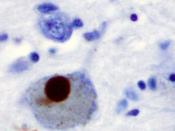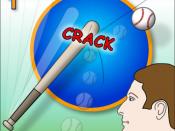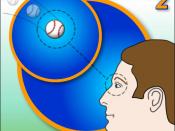Axia College Material
Appendix C
Brain Response of Behavior
Part I
Note: Parts II and III follow below, complete all three.
Run Multimedias 2.3 and 2.4
Go to the Web site www.prenhall.com/morris.
Click text: Psychology: An Introduction (12th ed.)
Click "2" on the select a chapter tool bar.
Click Live!Psych on the left hand menu.
Select 2.3 and 2.4.
Write a 350- to 700-word response to the following: Explain the communication process of neurons in the brain. List some common neurotransmitters and describe their effect on behavior.
Light, sound and odors, for example, are transformed by our sensory organs into a code made of series of electrical impulses that travel along neurons from the body to the brain. Information about the onset and the intensity of a stimulus is thought to be sent to the brain by the timing and frequency of these electrical impulses. How information is sorted by the brain has been an open question.
The group discovered that different neurons in the brain are dedicated to respond to specific portions of the information.
Dopamine
Dopamine produces excitatory or inhibitory postsynaptic potentials, depending on the postsynaptic receptor.
Most dopamine is produced and secreted by the Substantia Nigra.
Degeneration of the Substantia Nigra causes Parkinson's Disease, a movement disorder characterized by tremors, rigidity of the limbs, poor balance, and difficulty in initiating movement. The cell bodies of the neurons that produce dopamine are located in the Substantia Nigra. People with Parkinson's disease are given L-Dopa, a drug that stimulates the production of dopamine, thus causing more dopamine to be released by the surviving dopaminergic neurons.
Role of dopamine
Involved in controlling or initiating movement
Regulation of mood. Imbalances of dopamine have been associated with disorders such as schizophrenia or depression.
Norepinephrine
Also known as noradrenaline
Produced from Dopamine in the cytoplasm of the terminal button and stored in synaptic vesicles.
Role of Norepinephrine
In the brain, norepinephrine is released by the Locus Coeruleus, and has an inhibitory effect. It is believed that in the CNS, norepinephrine is primarily involved in control of alertness and wakefulness.
In the sympathetic nervous system norepinephrine has an excitatory effect. Released by nerves in internal organs, including the gut, spleen, and heart.
Regulation of mood. May be responsible for some symptoms of depression.
Epinephrine
Also known as adrenaline
Synthesized from norepinephrine in the adrenal medulla, the central core of the adrenal glands.
Role of Epinephrine
In the brain, the role is not entirely known, but it is believed to play a role in the way the brain regulates blood pressure.
In the periphery, it is the main circulating exciting transmitter released during the "fight or flight" stress reactions.
* It is important to note that most of the receptors sensitive to norepinephine are also sensitive to epinephrine. All of these receptors are coupled to G proteins that generate the second messenger cyclic AMP.
�
Part II
Refer to Ch. 2 (pp. 58-78) In Psychology: An Introduction.
Write a 350- to 700-word response identifying the major regions of the brain and what functions of behavior the systems of each region control.
Region | Function(s) |
Cerebrum | |
Frontal Lobe | the primary motor cortex of the frontal lobe controls movement of the body parts |
the prefrontal cortex has an important part in memory, concentration, temper, intelligence and personality | |
the premotor cortex is beside the primary motor cortex and guides our eye and head movements and sense of orientation | |
Broca's area is important in language production | |
Occipital Lobe | contains the visual cortex |
the right side of the brain 'sees' the left visual space, whereas the left side of the brain 'sees' the right visual space | |
the visual cortex aides in the recognition of visual objects | |
Temporal Lobes | contains the auditory cortex helps that receives signals from the ear and lets us hear sounds and associate meanings with sounds |
responsible for memory | |
the Wernicke's area is important for language and speech | |
Parietal Lobes | coordinates signals received from other brain resgions to interpret sensory signals |
coordination of visual, auditory, motor and sensory signals along with memory helps to identify objects | |
Cerebellum | important in refining movements, balance, equilibruim and posture |
controls muscle tone and body position | |
tumors or lesions here may cause jerky movemen | |
Brain Stem | relay station connecting much of the body (via the spinal cord) to the cerebrum |
considered a 'primitive' structure of the brain | |
together with the thalamus control wakefulness, attentiveness and sleep pattern | |
Midbrain | |
ocular motion | |
Pons | |
eye and facial movements | |
facial sensaton | |
hearing | |
balance | |
Medulla oblongata | |
breathing | |
blood pressure | |
heart rhythms | |
swallowing | |
Pituitary Gland | the 'Master gland', responsible for secreting numerous hormones |
growth hormone (GH, somatotropin) | |
luteinizing hormone (LH) | |
prolactin (PRL) | |
adrenocorticotropic hormone (ACTH) | |
thyroid stimulating hormone (TSH) | |
follicle stimulating hormone (FSH) | |
melanocyte stimulating hormone (MSH) | |
antidiuretic hormone (ADH) | |
oxytocin | |
isolation of hormones from this gland (which is in part an extention of the brain) and subsequent injection into humans was responsible for an outbreat of iatrogenic CJD | |
Hypothalamus | helps to control the pituitary gland and thus hormone secretion |
controls eating behavior, sexual behavior, sleeping and body temperature | |
Pineal Gland | its function in humans is still unclear but may aid in dark light responses and cycles |
Thalamus | relay station for pain sensation and alertness |
Spinal Cord | the spinal cord receives information from skin, joints, and muscles |
sends back signals for both voluntary and reflex movements | |
transmits signals from internal organs to the brain and from the brain to internal organs | |
connects the brain to peripheral organs and tissue | |
in addition, the spinal cord contains | |
ascending pathways through which sensory information reaches the brain | |
descending pathways that relay motor commands from the brain to motor neurons |
�Part III
Consider the following chain of events. Describe in 350-700 words the sensory process that takes place as the scenario unfolds.
BEH 225



Hard to follow
you did a good job, very professional, but it was hard to tell where one paragraph begin and where it end. it might be a good idea to use the enter key to a lesser extent. overall, good if your planning to become a neurologist.
0 out of 0 people found this comment useful.